 |
The capital La Paz - A city with records

La Paz is the biggest and most important city of the South American republic Bolivia and also has some records to offer: With the airport in El Alto at a height of almost 4100 m, the city owns the highest civil airport of the globe. At the same time, the city is also the highest located seat of goverment of the world (the capital is Sucre located in the south of Bolivia), and the altitude difference between the lowest and the highest point of the city is with more than 1000 m also record breaking. But don't worry, one does not have to make this huge altitude difference on foot as there are countless buses, taxis and colectivos (collecting taxis) in La Paz. Together with the almost vast number of stands with commodities for the daily use, these means of transport mark the streets and alleyways of the city.
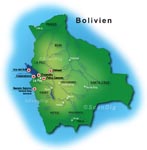
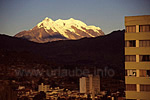
The city La Paz in the west of Bolivia with a population of approximately 1,8 millions inhabitants actually consists on two city parts which are EL Alto located on the huge and flat Altiplano (this is the way the highland plain of Bolivia on a height of 3800 - 4100 m is called) and the centre that is located in a huge valley basin, either with an oldtown as also with very modern high rises that remind on the European standards. From the valley basin, there are countless poor wooden huts expanding on the hillsides up to El Alto and on the other side up to the mountains.
Due to this reason, La Paz does not offer a very homogeneous image at the first sight as for example a European city; but specially the combination of tradition and modernity, indigenous markets, colonial oldtown, boutiques and business buildings provide a very special and almost fascinating atmosphere in which indios and mestizos (half breeds), criollos (of Spanish origin) and also Europeans live together. Over all that, the massive Illimani enthrones distinctively, the highest mountain heighted 6462 m of the mountain range Cordillera real bordering with the Altiplano.
History of Bolivia and La Paz
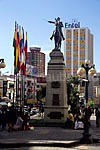
During the domination of the Incas whose empire expanded from the capital Cuzco in Peru to Colombia in the north up to very far into Chile, Bolivia was a part of this huge kingdom. In the years 1532-1535, the Spaniards conquered some wide parts of the Inca empire and therewith also Bolivia. The "City of our woman of piece", La Ciudad de Nuestra Señora de La Paz, was founded on 20. Oktober 1548 on the ground of an old Inca settlement named Choqueyapu in memory of a hindered rebellion of the indios. Despite of the inconvenient height of almost 4000 m, in the following decades and centuries, La Paz developed to the biggest and most important city of Bolivia and also to the cultural centre of the country. Specially the convenient situation at the intersection point of the Spanish via de la plata of Potosi (with 4062 m still before La Paz the absolutely highest big city of the world) to Peru and the coca-trade path of the Yungas (Mountain and cloud forests at the eastern slope of the mountains) contributed to it.
But when Simon Bolivar declared the independency on 6. August 1825 and founded the republic Bolivia, not La Paz but Sucre that is located in the south of the country at a height of 2790 m became the capital. But today, this denomination is only nominaly owned by Sucre, as it lost almost all functions in favour of La Paz that became seat of gevernment in the year 1899. Therewith, La Paz is also the political centre of Bolivia with a parlament building and a president palace.
Flight to La Paz and arrival
Normally, the biggest part of travellers and tourists who want to get from Europe to La Paz will take a flight. Specially IBERIA, LANChile and VARIG fly to the highest located airport of the world, most of the time by having a stop in Rio de Janeiro and/or Sao Paulo or Miami.
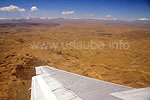
This was also the way in August 2004 when a group of 7 mountaineers started the way from the airport of Frankfurt for spending some good two weeks in Bolivia. Some of us already made a feeder flight from zurich or Munich when we met in Frankfurt. It was not only because of our abundant luggage but specially because of the whole climber gear including mountain boots, climbing suit, gore-tex coat and fleece coat everyone of us was wearing in a heat of more than 30°C in the shadow because of the excess baggage limit of 20 kg, we attracted the attention of many flight guests and people who were working in the airport.
Then we flew with the Brasilian airline VARIG in an airbus almost 10.000 kilometres over the Atlantic up to Sao Paulo where we land after 12 hours on the airport of this Brasilian metropolis of more than 10 million inhabitants in the morning dawn. After a stop in between of 5 hours, our plane, this time a quite rickety one, started in direction to La Paz. After another stop in between in Santa Cruz amidst the Bolivian lowlands (before opening the door, something against malaria mosquitos was sprayed) we finally approached our destination: La Paz.
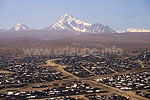
Everyone of us was quite excited, maybe it was because of the happyness of having finally arrived at the destination, the supposedly dream view to the Altiplanos and the mountains from the plane or the unconsciousness of how our organism would react to the unusual and sudden height of 4100 m. This corresponds to the peak heights of most of the four thousanders in the Alps! Before that, we heard from other people that they had to lay in bed several days with headaches and nausea or even had to get medical attendance due to the acute altitude sickness.
Shortly before the landing, the Altiplano of Bolivia presented itself in full size and beauty, and behind it, the peaks of te Cordillera Real covered with snow raised. Due to the altitude of the runway and the related reduction of air pressure, the bigger planes almost need 5 kilometres to take off and/or decelerate. Thus, we were also happy when the plane finally stood, as we already thought the brakes are defect and we would soon land on the houses.
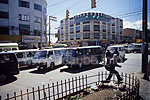
Afterwards, the usual things, picked up the stamp at the immigration office, passport control, waiting for the luggage and, surprinsingly, everything arrived; And more surprinsingly, we had no bigger problems with breathing but rather some liberating fresh air. But most of the times, such an altitude sickness is noticed after a certain time, thus we have to wait.
We were greeted by our travel guide for the first week, Erich Hochhäuser, half Austrian, half Bolivian, got in the taxi bus and drove to the middle of the traffic turmoil of El Alto. Almost 95% of all vehicles in La Paz are used as a taxi, thus there is no need to walk and the streets are respectively crowded. Another reason not to walk is that pedestrians are anyway not highly considered!
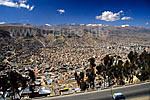
During the transition from El Alto into the big valley basin at a tollbooth, an impressive view was offered to us: Houses as far as the eye can reach, the mountains of Huayna Potosi and Mururata, and thereafter the dominating Illimani. After a short photo break we continued our drive, fascinated from all this, on a kind of city motorway into the centre and to our hotel Radisson Plaza located right at the Prado, the core of La Paz. There, we first had some cups of coca tea; this tea is supposed to be helpful to cope better with the unusual altitude and avoids a headache. And it really seemed so: no one of us noticed the altitude.
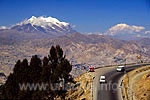
We spent the afternoon by chanching some dollars and/or euros in bolivianos (10 bolivianos are approximately one euro; there are numerous cash dispensers with service for EC-cards), with some first little walks up to the Plaza San Francisco, visiting the recommendable Cafe La Terazza, and specially with buying some water in order to liquefy a little the blood that is thickened due to the lack of oxygene (due to the increased numer of red blood cells for the transportation of oxygen) by drinking a lot of water. The disadvantage of this increased water intake was noticeable at night: We had to go continuously to the toilet!
We had our first Bolivian meal in the cozy garden pub Club de la Prensa in a side alleayway of the Prado; and had a chilled cerveza; in La Paz, an excelent beer is brewed to which even the Bavarians would not say no! After a quiet recovering night and an extensive breakfast we were full of expectation to make the first excursions and specially a city viewing tour.
A city viewing tour in La Paz
The city La Paz offers such an abundance of worth experiencing things and sightseeings to the travellers and those who are interested in culture as churches, plazas and streets full of history, museums (more than 15), colourful indio markets, garden complexes in the lower city district and much more, that surely several days have to be planned in order to see all this and specially also to experience the life of the people and the special flair of this city. But normally, one will not stay in La Paz more than one or two days but travel to the lake Titicaca in the north-east and continue to Peru, travel to the south in direction to Salar de Uyuni and Atacama desert, visit the jungle of the Amazon basin, or join to some trekking– and mountain tours in the lonely and rough high mountain world of the Andes.
In the following city tour that takes half of the day starting from the Prado we explore the most important sightseeings of the city centre. It can be easily done on foot and this is also recommendable as by moving a little one gets better used to the altitude and one also experiences the hustle and bustle and the daily life of the people more vividly as from the seat of one of the numerous city tour buses circulating through the city; The advantage of a bus tour are surely the comments and explanations of the tour guide, but one is really fascinated by the sightseeings and most of the times cannot assume all the related information; With the help of the following descriptions and eventually a travel guide, one should be able to handle the city without a guide.
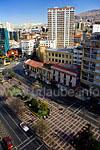
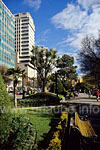
Let us start our small city tour at the Paseo El Prado, shortly Prado. It is the boulevard and the lifeline of La Paz that extends over a length of several kilometres from the Avenida Montes at the north up to the Avenida Arce at the south and splits the city centre in two areas, on one side the Indio district with countless markets and the other side the Spanish influenced district with the statutorial buildings. The most beautiful part of the Prado is the section from the Plaza San Francisco up to the Plaza del Estudiante. There, at the edge of the roadway that is mostly crowded with cars and buses, some very modern high rises and hotels alternate with some gorgeous colonial houses; coffee bars, snack bars and restaurants string together, and almost any ten metres, an old indio woman scarred by her hard life stands behind her small stand.
In the area around the monument of Simon Bolivar there is a green middle strip were even plants were arranged and one has the feeling to be rather at the Côte d'Azur than in Bolivia at a height of 3600 m. I was specially fascinated by the cleaness of the streets compared to the European big cities, and this is provided by some green aliens (they really look so in their green overalls), that do not anything but remove immediately the smallest piece of dirt.
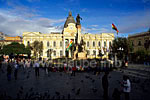
From the Bolivar monument we follow the Prado in direction to the Plaza San Francisco and turn to the right into the street Calle Yanacocha in the Spanish district and get to the Plaza Murillo, the most inmportant plaza of the oldtown. At the edge of the plaza that is called after the rebellion leader Murillo that had been hung here in the year 1810, there is the president's palace, the parliaments's building built in neoclassical style and a cathedral that was finished in the year 1988 after several centuries of building time. In the course of the time, the Plaza Murillo was the scene of more executions, whereby also the heads of the state were not saved from that, and by this way, Bolivia's history is of more than 200 violent changes of government since the year 1826.
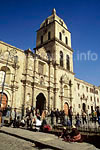
A house in front of the parliament's building has some evidences of the last big rebellion of the year 2003 with a later change of president: on the cladding, there are some bullet holes that were generated in some violent turbulences between the police and the military and numerous killed people; the reasons for that were social housing, tax increases and the continuous discrimination of the indigenous population, but also the disputed export of natural gas to the USA. With the induction of president Carlos Mesa in October 2003, the situation mainly calmed down. During our visit in August 2004, either young and old people were bustling peacefully on this Plaza full of history and we can only hope that the situation remains like that.
Our next destination are the idyllic alleywas of the Calle Jaen. One gets there by shortly following the Calle Comercio from the Plaza Murillo passing the museum of arts up to the Calle Yanacocha. No we go up at the right and get to the Calle Indaburo after the Iglesia Santo Domingo. Passing the city theatre on the left side we finally arrive at the Calle Jaen. This is probably the most original and beautiful alleyway of La Paz, one feels like being put back for several centuries due to the uniform claddings of the small houses and the lack of current cables.
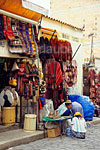
The freedom fighter Pedro Domingo Murillo lived in a house with a nice courtyard, a visit to this small museum is recommendable. Until now, we had to walk upwards, but now, our way goes downwards to the Avenida Montes and over the Plaza Velasco to the Plaza San Francisco with the same named church. Many times, some manifestations and concerts take place here, or, as we noticed amazedly, also an activity of a dog association with a collective vaccination of the animals: We already wondered all the time why there were so many people with their dogs in the centre, now we got the answer!
The Basilica San Francisco was built in the year 1549 and got its baroque shape that is visibly today in the year 1744. For the building, even some stones of the excavation site of Tiwanaku have been used, and the claddings were abundantly adorned by some indigenous masons. We were lucky and could take part on a church service in church; Although the big majority of the population is catholic, there was a very different atmosphere, according to my feeling a much more relaxed one as in our home country during a church service that is accompanied by some nice sounding music
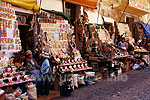
After the pleasant calmness of the church, we walk a little up to the beginning of the Calle Sagarnaga, the famous shopping mile of La Paz and we are already amidst the hustle and bustle of the market district. The area of the C. Sagarnaga offer specially to the tourists an almost vast quantity of different gifts and souvernirs. The offer goes from warm jumpers, caps and coats made of alpaca wool, different art objects and beautiful silver jewelry to traditional instruments as panpipes up to blankets and bags in vivid colours, and much more things.
If there was no baggage limit in the back flight, one could take travel bags full of these beautiful things home, specially because, compared to Europe, they are very cheap. For example, one gets a warm alpaca jumper for 10 euros, at home we pay 80-100 Euro for that! Additionally, it was really good fun to bargain with the always friendly people despite of my poos Spanish knowledge and to see that in the end both sides were happy with the result. One only has to dare to bargain!
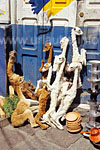
By walking further the C. Sagarnaga uphill, we get at the right to the Calle Linares, the so-called magic alleyway. There are some old indio women sitting with some faces marked by the wind and the weather, behind their small selling stands with all kinds of powders, herbs, elixirs, pickled animals that are supposed to banish ilnesses and evil spirits. What I found specially macabre were the abundantly offered lama embryos, but according to the belief of the indios, they will bring some luck to the inhabitants of new built houses if one is walled in at each of the four corners of the house. There, the topic "Different countries, different customs" has a true meaning!
One should be careful with photographing the market women or genrally women! According to the women's opinon, by photographing their faces, their souls are taken away, and this is why they rapidly turn around as soon as they see a camera. Due to this reason, one should handle this with some sensibility and/or one tries to make the pictures in a hidden way or gives the soul back by paying a boliviano, as then they even smile into the camera!
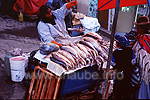
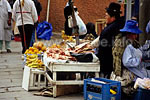
After this short excursion into the kingdom of the herb witches, a side trip to the hut city in the area of the Calle Santa Cruz is worthwhile. We get there by follwing the "witches alleyway" up to the end. All of a sudden, we are in a labyrinth of market stands that were all covered with some blue plastic tarps and soon, one really gets lost and does not know anymore from which direction one came. These small alleyways are much too labyrinthine in which all kinds of shoes, from sports shoes up to high quality leather shoes, modern clothing, jeans, sports stuff, records, CDs, and much more modern staff is offered. If we then hopefully land again on the Calle Santa Cruz after all that, we better get back through the witches alleyway to the C. Sagarnaga, in order to visit the fruit and vegetable market that begins at the other side.
Many people will surely wonder why there are so many markets and small selling stands in the indigeneous part of La Paz. The answer is the mentality of life of the indigenous city population. They spend more or less the whole day on the street! Only in the nights they return back to their houses and wooden huts. This is the reason why in La Paz, except in the lower richer part of the city, there are practically no shopping centres or supermarkets, it is bargained on the streets! And many times, it is the only possibility for the poor population to survive with the income of the sale of all kinds of stuff at their stand.
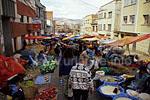
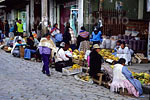
What is very outstanding is the concentration of the goods in certain market sections. By this way, in an alleayway there are only shops with electronic goods, in the next one there are only hair dressers, one street further there is, beside the fish also the meat and coldcut market, where in between the stands with some hanging halfs of pork and beefs, rambling dogs are looking for something eatable - not very appetizing - or the meat is straight offered on the table without any cooling.
The fruit and vegetables market is one of the most important and biggest markets where we actually are now. Also those who know the varied offer of the Viktualien market of Munich will be amazed. In the following, I will mention only a few of the offered goods: Dozens of different sorts of potatoes (Bolivia is considered as the country of origin of potatoes), any kind of vegetables (some of them unknown to us), peanuts (three times bigger than the ones of Europe), huge papayas, ananas and mangos, bananas, as far as the eye can reach. And the taste is not comparable to the imported goods in our home country, the bananas and papayas are divine to our palate!
Furthermore, the most different spices, honey, dried spices and specially bags of coca leaves. Our travel guide immediately introduced us into the practice of chewing coca leaves, whereby approximately 15 leaves are chewed with alcaline plant ash (Lejia), and the cocaine contained in the leaves, mixed with the saliva, turns to alkaloid ecgonin. But don't worry! One neither gets high or addicted, as therefore, the quantity of active ingredients is much too small, but it has a stimulating and analgesic effect. At the beginning, it was a strange feeling when after approximately 5 minutes, my cheek and my tongue became really paralysed and I felt a little tipsy and lighter. The chewing of coca leaves is specially practiced by the indigenous people in the social life, whilst hard physical work or also for healing purposes. It became a pleasant ritual during our journey! In this context, the visit of the Museo de la Coca is recommendable, it is located at the corner Sagarnaga/Linares.
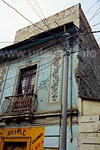
We leave the busy and also sometimes hectic hustle and bustle of the markets with permanent impressions but unfortunately no only nice ones (e.g. the waste simply ends on the streets, a thing that made us sometimes "turning our noses up") and follow the downhill leading streets up to the Calle Murillo. Here, there are still numerous houses in colonial style with beautiful ornaments on the walls, but many of the former gorgeous buildings meanwhile require renovation, but unfortunately, there is not enough money for that. What is outstanding in almost the whole of Bolivia is that the power supply lines are quite messy to our eyes. But apparently, the electricians can handle this very well...
We end now our small city tour and continue walking a little downhill up to our starting point, the Prado. After we made our city exploration on foot and therefore have had some physical activity and meanwhile feel a little hungry, we find in La Paz a wide offer of culinarian delicacies.
Food, accommodation and entertainment in La Paz
A trip to other countries and different cultural environments is also oftenly linked to a trip into almost unknown and unusual country's cuisine with its typical ingredients and dishes, and for many people, this even is the special attraction of an overseas travel.
This is why before the trip I informed myself with several travel guides what culinarian offers would wait for me in Bolivia; what is similar to our food, what is different, and how far the American fastfood (Name is not mentioned here!) expanded in Southamerica. I read about some different potato and corn dishes, about quinoa (never heard it before), many pork and chicken dishes, Bolivian fastfood from the cookshops, and to my surprise, also guinea pig- and lama meat. Well, I was really wondering how the meat of a spitting lama would taste and what else would be served on the table!
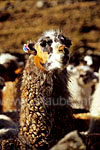
In order to mention it from the start, in the time we visited La Paz there was only one american fastfood-restaurant in the city. The burger chains certainly opened a lot of branches but except one all had been closed due to the low demand. But those who cannot abstain from the loved burgers will find some snack bars at the Prado, where one gets a tasty burger made for less than one euro.
For the small snack in between, the cookshops of La Paz are specially offered that are almost located in the markets. There, one gets for only a few cents tasty barbecued corncobs and, as the name already suggests, some cooked vegetables. One should not miss to try the recently fried papas fritas, we would call them crisps. The taste is not comparable to the crisps sold in the supermarkets in our home country. Those who prefer something sweet and cookies as a snack will find an abundant offer at the small sales stands. There is also the best possibility offered to get a dispense of water and lemonade, only the sales of alcoholic drinks is strictly forbidden, therefore one has to get to the small beverage markets.
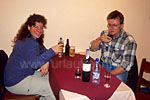
A good tip for excellent coffee specialities is the Café La Terazza right at the Prado, additionally, one gets here some big pieces of cake and tasty sandwiches. If then one gets really hungry in the evening, one will be spoilt for choice what exactly to eat. Specially at the Prado there is, beside the local cuisine, also typically European dishes in offer as pizza and pasta and also some Chinese restaurants. If one wants to dine in the real traditional Bolivian and also cheap way, the restaurants in the indigenous districts are the right choice. We got the tip fro out travel guide to try the excellent guinea pigs served in the Casa del Corregidor in the C. Murillo, but unfortunately it was closed so that unfortunately it was refused to me to try one of those animals (or maybe luckily).
Therefore, we had some lama steaks with sweet potatoes, manniok and quinoa, a cereal that contains a lot of proteins, in a more posh restaurant (unfortunately I cannot remember the name). The lama meat was really tender, the taste something between beef and game, and specially recommendable for those who are nutrition-conscious as it is very low of cholesterin. It tasted to me excellent, although I also felt sorry for these nice animals. For this dish and a previous salad from the buffet and additional live piano music I paid approximately 5 euros. As it is obvious, one can dine in a very posh way for little money in La Paz.
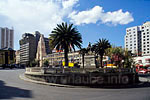
The poultry lovers among the travellers will not be able to avoid the pollerías; there are the most different chicken dishes offered in the menue card. Apart from an excellent beer, it is also recommendable to have this dish with a bottle of Bolivian wine, although it is not realy cheap compared to the dishes. In Bolivia, the wine-growing is relatively new and unknown, but the fact that Southamerican wine is able to compete in the market is impressively shown by the neighbour countries Chile and Argentina.
A must for every tourist in La Paz is to visit a peña, this is a folklore show in which it is danced and sung in the very colourful Bolivian costumes to the traditional andine music while the expectors enjoy their meal. We could admire this spectacular show in the Peña Huari in the C. Sagarnaga, and myself I was even allowed to dance with a pretty Bolivian woman, a thing that due to the altitude of La Paz was really exhausting to me. But as reward I got a schnaps from a jar that contained a snake - cheers!
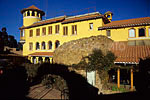
Unfortunately, when it comes to paying the bill one soon notices that this spectacle is a pure tourist attraction so that the prices make one soon feel home. After this small shock we anyway have a relaxed walk over the still highly frequented Prado at midnight, enjoyed La Paz at night and went back to the Hotel Radisson Plaza, a five stars hotel located right at the lower end of the Prado. Unfortunately, it was a quite ugly concrete block and considering the high amount of stars, the rooms were relatively insipidly arranged; we did not feel really comfortable there. But therefore, a rich breakfast was offered in the mornings with all imaginable delicacies so that could start the new day well nourished. As we all booked the journey at a German travel agency, we could not take any influence on the choice of the hotel. I do not want to say that this hotel was not recommendable at all but according to my opinion it is simply much too less offered for 100 euros per night.
For the individual traveller and the small budget there are many hostels in La Paz where one can get a simple accommodation for approximately ten euros. But those who prefer a little more upper level but still cheap the Hotel Residencial Rosario in the Avenida Illampu is recommendable. Ourselves we certainly did not spent any night in this hotel, but we made some very good experiences in the branch hotel Copacabana. The hotel is built in a style that reminds a little on the Toscana, has some very comfortable and clean rooms and the offered service is very cheap for approximately 35 € per night with breakfast.
Another tip is the Hotel Oberland in the lower area of La Paz located at a height of approximately 3200 m at the gate to the Valle de la Luna and therewith optimal for those who like it more tranquil or have some problems with the adaptation of the altitude. The hotel with a nice garden and majorly German speaking guests is examplarly managed by a Swiss man, we enjoyed there once an excellent meal and were really satisfied with it. From the city centre one gets to this hotel after a taxi drive of approximately 20 minutes.
After we got a little introduced to the impressive and fascinating city La Paz and got a small insight into its life and city inhabitants and got acclimatized, we finally start to explore the surroundings of La Paz.

Back to the index Bolivia
Author: Flori Forster; Copyright: Patrick Wagner, www.tourist-guide.biz
|
 |